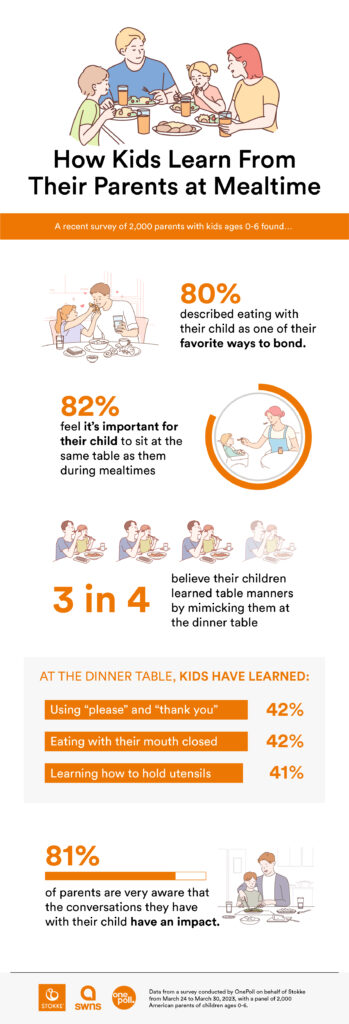By Victoria McNally // SWNS
NEWS COPY W/ VIDEO + INFOGRAPHIC
Want to get your kids to eat their vegetables? Eat your own first.
A recent survey of 2,000 parents to children ages six and younger found that 53% have noticed their kids eating unwanted vegetables specifically to mimic them.
Overall, 78% believe their children learned their table manners specifically by imitating them at the table.
Conducted by OnePoll on behalf of Stokke, the survey found that 82% feel it’s important for their child to sit at the same table as them during mealtimes, and that 80% described eating with their child as one of their favorite ways to bond.
Most respondents began feeding their children solid food between 6 to 12 months of age, but didn’t synchronize their meal schedules together until their child was between 13-23 months old.
Once they did, however, they described themselves as less likely to make different meals for them and their children (45%), instead opting to eat the same foods together (75%).
Almost half (48%) reportedly never make separate meals for themselves and their children, making it five times more popular than always making separate meals (7%).
And although fewer people (72%) said it’s important that their meals are eaten at an actual dining or kitchen table, that kitchen table also ranked high among the most potent places for bonding time to occur (45%), just behind bedtime (47%).
“Every interaction is a window of opportunity for learning and development,” said Johanne Smith-Nielsen, Associate Professor Ph.D. Clinical Psychologist at the University of Copenhagen.
In fact, 70% of respondents said they frequently notice their child learning from their own behavior.
The most commonly adopted manners kids typically learn from their parents include using “please” and “thank you” (42%), eating with their mouths closed (42%), and figuring out how to use utensils (41%).
But it’s not just during mealtime, as 73% have witnessed their child use the same language as them in conversations, picking up complex words and phrases like “predicament” or “appropriate,” in addition to common expressions like “thank you” or “excuse me.”
“I think that it’s so heartwarming when a child shows gratitude for the little things,” one parent said in an open-ended response. It’s a great gift that they will carry with them for the rest of their lives.”
Overall, a whopping 81% of parents are very aware that the conversations they have with their child have an impact.
“The table is where real growth occurs. It’s where we take the time to slow down, connect, listen, and learn from each other,” said a spokesperson from Stokke. “Sitting together at eye level throughout childhood allows them to bond, connect, and form deeper relationships.”
MOST COMMONLY UNDERSTOOD TABLE RULES AMONG KIDS 0-6:
- Using “please” and “thank you” - 42%
- Eating with their mouth closed - 42%
- Learning how to hold utensils - 41%
- Asking nicely for second servings - 39%
- Finishing what’s on their plate - 39%
- Letting others talk - 35%
- Not screaming - 34%
- Not burping - 29%
Survey methodology:
This random double-opt-in survey of 2,000 American parents of children ages 0-6 was commissioned by Stokke between March 24 and March 30, 2023. It was conducted by market research company OnePoll, whose team members are members of the Market Research Society and have corporate membership to the American Association for Public Opinion Research (AAPOR) and the European Society for Opinion and Marketing Research (ESOMAR).




